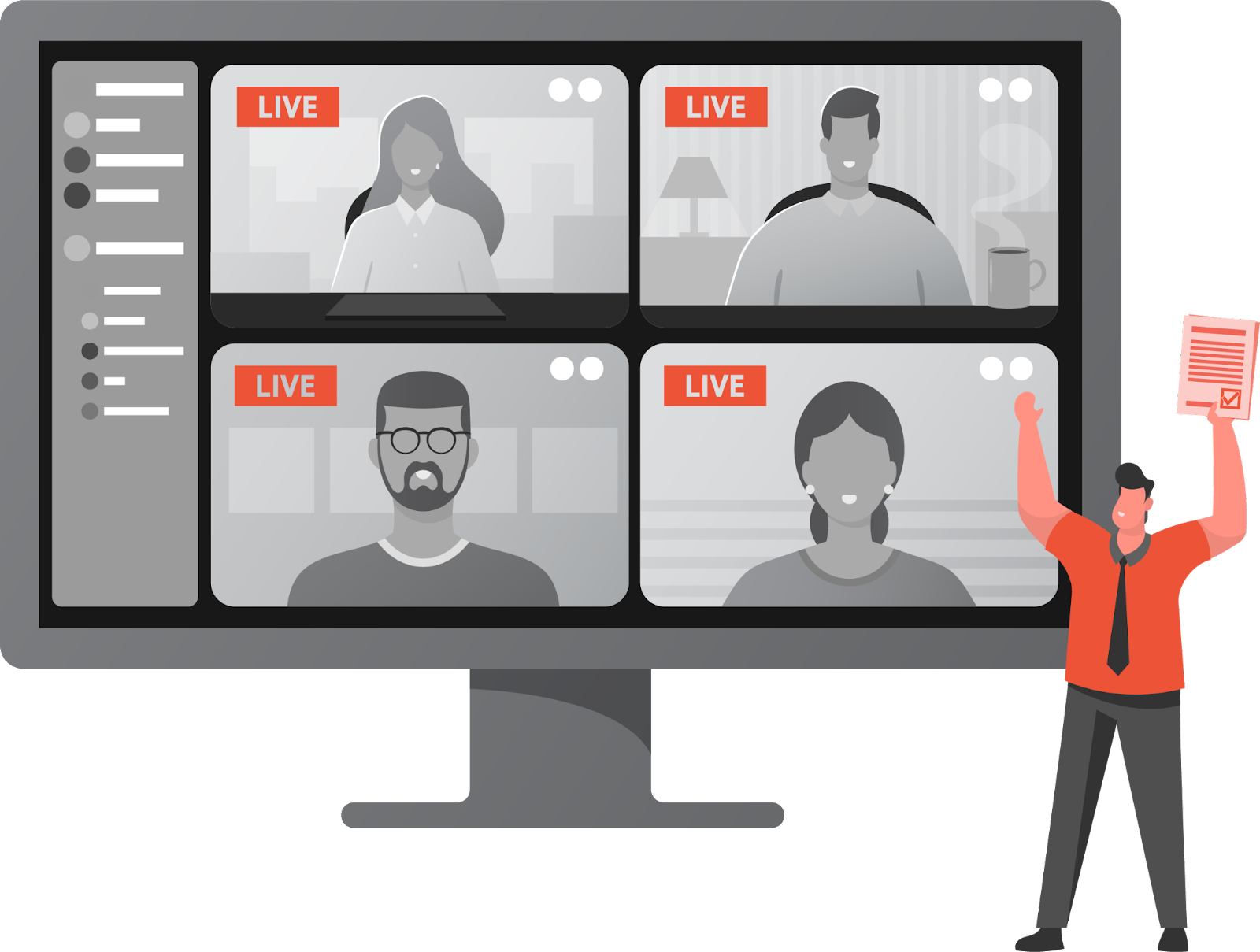How to Best Design a Hybrid Work Environment
You must have heard of them by now, these fancy new work environments. In the wake of a global pandemic, people had to come up with all-new ways of gathering and working, and a few of these methods seem to have struck a positive chord. With all this talk of “Work from Home” here, and “Work from Anywhere” there, and how they’re the future of the workplace in a post-covid world.
“It’ll boost productivity!”, they say. “Employees love it! It helps create the best work-life balance!” These statements ring true, generally – though there’s a bit of nuance at play. These successes are not universal, and there are some things that classic work structures are just superior for.

Online workplaces just can’t replicate the feeling of being around people. It’s hard to develop office friendships, meet new people, and forge career-building connections (Bloom, 2021b). And that’s just one example.
So, is there a way to get the best of both worlds? Can we pick up all the productivity benefits of WFH without abandoning the benefits of office work? Turns out: the answer may actually be “yes”. A “Hybrid model” aims to do just that. And with the help of research data, we aim to demonstrate exactly how that works, while giving practical advice on how that data can improve your business.
This article is all about understanding. We’re not just going to give you a few bullet points and call it a day, falsely satisfied in the knowledge that our readers can most definitely, 100% apply this knowledge in the best possible way. We know that’s not true – and any article claiming otherwise will inevitably lack the depth you need to truly see the benefits of a hybrid workplace model. In this industry, there is no one-size-fits all solution. Every business is different, and knowing the hows and whys are the ingredients to creating the best system that fits your business. Take our advice to heart, but don’t feel as though you need to follow each step to the letter. Nobody knows your business like you do, and that means you’re in the best position to know what is and isn’t beneficial. Pick the options that work best for you.
Developing an Understanding
So, first things first. What exactly is a “Hybrid model”? We know the things being hybridized – working from home, and working from an office. This isn’t a question of definitions, but of degrees. What is the balance that a hybrid workforce aims for?
The exact numbers tend to vary. Some companies prefer to lean on the WFH direction, only calling employees together for larger meetings, discussions, and so on. Others operate mostly from an office, sometimes encouraging people to work from home on 2 out of the 5 weekdays. Other companies leave that choice up to the worker themselves.
There is a significant amount of variance between how often people actually want to work from home. Some groups prefer to spend as much time as possible at home. The next biggest group of people only want to work at home “rarely or never” (Bloom, 2021a).
Each of these options will vary – both in their effectiveness, and in how much management work it creates for anyone trying to organize staff. We will dive more into that distinction later.
Hybrid work also varies in popularity from generation to generation. The older crowd, as you may expect, prefers to work in the way they’ve always known, and are more resistant to change. Meanwhile, for a group like generation Z, the results are intriguing: 74% have a preference either for working from home, or in a hybrid model (Afshar, 2020).
But one universally-loved popularity metric is the stat on productivity. It doesn’t apply in literally every case, as employees living with children may face more distractions than others (Toscano et al, 2021), but speaking in very general terms, most workplaces will see a boost. In workplaces that introduce WFH policies, 83% saw productivity increase to some extent (Hunter, 2018).

One study from Stanford University had something really special to say about WFH productivity: that it was equivalent to an entire extra day of work completed each week (Bloom et al, 2013). Do note that this comparison is based on employees working fully from home, as opposed to working fully from an office. The hybrid model will see this boost in a partial sense, but not fully.
Most articles will immediately follow this productivity data up with how popular WFH is among the workforce itself. We already know the generational-based counterexample to that, but in most cases workers do, in fact, prefer a WFH option. 55% of them, in fact.
(Bloom, 2020).
Another study found that WFH was so valued, that it was worth 6% of an employee’s wage – they’d pay that to get a chance to work where they pleased (Bloom, 2021b). That willingness applies to 42% of the workforce, by the way (Corps, 2018).
With numbers like this, it’s no wonder why businesses are quickly catching on to the trend. 82% of businesses already have, or plan to, introduce some elements of WFH into their structure (Baker, 2020).
So as businesses make the shift, what is it that they’ll discover? WFH has differing strengths and weaknesses after all, and we just covered the strengths. So, what’s the catch?
As mentioned earlier, employees may struggle to find connections with other workers. Collaboration will be harder. Networking will prove challenging. WFH is really good for structures where everyone breaks off to work on their own thing, and discourages all other forms of work.

It’s possible that meeting productivity may also take a hit. For smaller meetings – say, between 4 workers – the downsides will be negligible. But for larger meetings, where everyone may struggle to fit on the same screen, issues can start to crop up (Bloom, 2021a). Even if everyone is easily audible, there are some messages that can get lost without a visual aid. People communicate using gestures and facial expressions fairly often, without even realizing they’re doing it. Likewise, many people can pick up these subtle details with relative ease, provided they have the information needed to do so. The lack of visual presence in a large digital meeting robs them of that information. As such, communication becomes more difficult.
A common worry that many business owners have is in regards to household distractions. To their credit, there are definitely times where workers can be hindered by the presence of so many attention-grabbing things. We already have data from crowded workplaces vs sparse ones (Terence, 2001), and the results prove our intuition. The difference is, though, that this doesn’t apply to WFH – at least, not always. Since workers are incentivized to maintain some level of productivity (the desire to keep one’s job is a powerful force), they have reason to minimize their own distractions. And since they work from home instead of an office, they now have the authority to do so. At least, they usually do.
Some factors are simply out of a worker’s control, though. Children are an easy example, but countless others exist. And for workers who may face them frequently, productivity may decrease. So while, in general, you can expect a productivity boost from WFH, it’s worth checking in with your workforce before instituting WFH policies, if possible. The productivity boost is not universal, but it is largely predictable.
The Best Model for You
Judging by all known sources, a hybrid model offers enough flexibility to maximize the strength of both WFH and traditional office models, while minimizing the weaknesses. But it’s a kind of flexibility that must be used mindfully, it’s not inherent to the process.
WFH has two main strengths: the agency offered to the workers, and the productivity increase for the employers. But it’s weaker in terms of collaboration and interaction between workers. Is it possible to maintain the agency that creates productivity, while maintaining the interpersonal aspects of a traditional office?
And so, we bring things back to our initial question. It’s clear that including some measure of WFH into your workplace model will be worthwhile. But it does come with some downsides. How much of those downsides are you, and your workforce, willing to endure?
The short answer is: it depends. That is why we spent so much time exploring the how and why of WFH – every factor depends on the needs of your business. How often do you need to assign collaborative tasks? How often do you hold large-capacity meetings? What does the typical home life look like for your average worker? If your answers are “often, often, and adults with young children to look after”, you may prefer to lean in a traditional direction. Other answers will, obviously, create a whole different kind of optimal model.
One significant choice that must be made in this model is in allowing workers to choose their own days worked from home. Will employees prefer to work Monday and Friday at home? Or perhaps Wednesday and Thursday?
Unlike the choice between WFH and traditional offices, you will likely need to take a firmer stance here. There are few generally-applicable sources in this area, which means you’ll need to choose the model that best fits your workplace.
For example: if you plan on coordinating an in-person meeting, or have multiple employees collaborate on a task simultaneously, then all those involved will need to ensure they chose the same day to arrive at work in-person. Since these same workers will likely be planning their own lives based on when they can or can’t be at home, they will need some predictive way to determine their must-be-at-work days. That means coordinating things far ahead of time, which means you need a system for archiving and distributing those predictions, and so on. If your business focuses very heavily on non-collaborative tasks, then such an endeavor may be worthwhile – but that will not be every business.
Another choice could lie in an inversion of that process. What if your business is on the other end of the spectrum, and benefits from a primarily WFH model? The disadvantages of WFH will need a counterbalance, but is it worth setting up an entire office complex just for that? The answer is likely a definitive “no”.
But that doesn’t mean the question is unsolvable. It just needs a shift in perspective. How can you get a powerful office space, if you won’t need or use it 24/7? The answer is, of course, a rental. There are plenty of services out there willing to host any number of employees – be it small teams or whole networks of people.
Book a meeting room in Toronto
If your business works best with a separated work/home space, but doesn’t need it to be a permanent fixture, The Professional Centre has plenty of options to fill your exact niche.

Pick up all the benefits of a centralized workplace, without any of the firm anchors keeping your business model rooted in a single method. Whether you need to service a large team or a small meeting, The Professional Centre can supply the exact kind of space you need to enhance your team’s productivity.
Works Cited:
Afshar, V. (2020, July 7). The future of work is hybrid: Work from home and the Workplace. ZDNET. Retrieved October 11, 2022, from https://www.zdnet.com/article/future-of-work-hybrid-home-and-workplace/
Baker, M. (2020, July 14). Gartner Survey reveals 82% of company leaders plan to allow employees to work remotely some of the time. Gartner. Retrieved October 11, 2022, from https://www.gartner.com/en/newsroom/press-releases/2020-07-14-gartner-survey-reveals-82-percent-of-company-leaders-plan-to-allow-employees-to-work-remotely-some-of-the-time
Bloom, N. (2020). How working from Home Works Out. Stanford Institute for Economic Policy Research (SIEPR). Retrieved October 11, 2022, from https://siepr.stanford.edu/publications/policy-brief/how-working-home-works-out
Bloom, N. (2021, June). Hybrid is the future of work. Stanford Institute for Economic Policy Research (SIEPR). Retrieved October 11, 2022, from https://siepr.stanford.edu/publications/policy-brief/hybrid-future-work
Bloom, N. (2021, March 21). Our research shows working from home works, in moderation | nick bloom. The Guardian. Retrieved October 11, 2022, from https://www.theguardian.com/commentisfree/2021/mar/21/research-working-from-home
Bloom, N., Liang, J., Roberts, J., & Ying, Z. J. (2013). Does working from home work? evidence from a Chinese experiment. https://doi.org/10.3386/w18871
Corps, M. (2018, June 30). Survey of working adults shows U.S. employees willing to take pay cut for workplace flexibility. Survey of Working Adults Shows U.S. Employees Willing to Take Pay Cut for Workplace Flexibility. Retrieved October 11, 2022, from https://www.prnewswire.com/news-releases/survey-of-working-adults-shows-us-employees-willing-to-take-pay-cut-for-workplace-flexibility-128877868.html
Hunter, P. (2018). Remote working in research. EMBO Reports, 20(1). https://doi.org/10.15252/embr.201847435
Terence M. Murphy (2001) The Effects of a Crowded Workplace on Morale and Productivity, Journal of Histotechnology, 24:1, 9-15, DOI: 10.1179/his.2001.24.1.9
Toscano, F., & Zappalà, S. (2021). Overall job performance, remote work engagement, living with children, and remote work productivity during the COVID-19 pandemic. European Journal of Psychology Open, 80(3), 133–142. https://doi.org/10.1024/2673-8627/a000015




